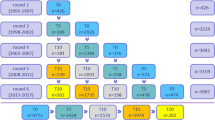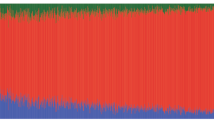Abstract
Variations in the S100β gene may be instrumental in producing a continuum from mild cognitive decline to overt dementia. After screening 25 single nucleotide polymorphisms (SNPs) in S100β, we observed association of the rs2300403 intron 2 SNP with poorer cognitive function in three independent populations. Moreover, we detected a significant association of this SNP with increased risk of developing dementia or Alzheimer's disease (AD) in six independent populations, especially in women and in the oldest. Furthermore, we characterised a new primate-specific exon within intron 2 (the corresponding mRNA isoform was called S100β2). S100β2 expression was increased in AD brain compared with controls, and the rs2300403 SNP was associated with elevated levels of S100β2 mRNA in AD brains, especially in women. Therefore, this genetic variant in S100β increases the risk of low cognitive performance and dementia, possibly by favouring a splicing event increasing S100β2 isoform expression in the brain.
This is a preview of subscription content, access via your institution
Access options
Subscribe to this journal
Receive 12 print issues and online access
$259.00 per year
only $21.58 per issue
Buy this article
- Purchase on Springer Link
- Instant access to full article PDF
Prices may be subject to local taxes which are calculated during checkout


Similar content being viewed by others
Accession codes
References
Drachman DA . If we live long enough, will we all be demented? Neurology 1994; 44: 1563–1565.
Hardy J . Amyloid, the presenilins and Alzheimer's disease. Trends Neurosci 1997; 20: 154–159.
Farrer LA, Cupples LA, Haines JL, Hyman B, Kukull WA, Mayeux R et al. Effects of age, sex, and ethnicity on the association between apolipoprotein E genotype and Alzheimer disease. A meta-analysis. APOE and Alzheimer Disease Meta Analysis Consortium. JAMA 1997; 278: 1349–1356.
Brayne C, Harrington CR, Wischik CM, Huppert FA, Chi LY, Xuereb JH et al. Apolipoprotein E genotype in the prediction of cognitive decline and dementia in a prospectively studied elderly population. Dementia 1996; 7: 169–174.
Kehoe P, Wavrant-De Vrieze F, Crook R, Wu WS, Holmans P, Fenton I et al. A full genome scan for late onset Alzheimer's disease. Hum Mol Genet 1999; 8: 237–2345.
Van Eldik LJ, Wainwright MS . The Janus face of glial-derived S100B: beneficial and detrimental functions in the brain. Restor Neurol Neurosci 2003; 21: 97–108.
Baudier J, Cole RD . Interactions between the microtubule-associated tau proteins and S100β regulate tau phosphorylation by the Ca2+/calmodulin-dependent protein kinase II. J Biol Chem 1988; 263: 5876–5883.
Mrak RE, Griffin WS . Interleukin-1, neuroinflammation, and Alzheimer's disease. Neurobiol Aging 2001; 22: 903–908.
Mrak RE, Griffin WS . The role of activated astrocytes and of the neurotrophic cytokine S100B in the pathogenesis of Alzheimer's disease. Neurobiol Aging 2001; 22: 915–922.
Connolly Jr ES, Winfree CJ, Rampersad A, Sharma R, Mack WJ, Mocco J et al. Serum S100B protein levels are correlated with subclinical neurocognitive declines after carotid endarterectomy. Neurosurgery 2001; 49: 1076–1082.
Amouyel P, Richard F, Cottel C, Amant C, Codron V, Helbecque N . The deletion allele of the angiotensin I converting enzyme gene as a genetic susceptibility factor for cognitive impairment. Neurosci Lett 1996; 217: 203–205.
Frederiksen H, Gaist D, Bathum L, Andersen K, McGue M, Vaupel JW et al. Angiotensin I-converting enzyme (ACE) gene polymorphism in relation to physical performance, cognition and survival – a follow-up study of elderly Danish twins. Ann Epidemiol 2003; 13: 57–65.
Van Exel E, Gussekloo J, Houx P, de Craen AJ, Macfarlane PW, Bootsma-van der Wiel A et al. Association between high-density lipoprotein and cognitive impairment in the oldest old. Ann Neurol 2002; 51: 716–721.
Richard F, Fromentin-David I, Ricolfi F, Ducimetiere P, Di Menza C, Amouyel P et al. The angiotensin I-converting enzyme gene as a susceptibility factor for dementia. Neurology 2001; 56: 1593–1595.
Rudrasingham V, Wavrant-De Vrieze F, Lambert J-C, Chakraverty S, Kehoe P, Crook R et al. Alpha-2 macroglobulin gene and Alzheimer disease. Nat Genet 1999; 22: 17–19.
Lambert J-C, Araria-Goumidi L, Myllykangas L, Ellis C, Wang JC, Bullido MJ et al. Contribution of APOE promoter polymorphisms to Alzheimer's disease risk. Neurology 2002; 59: 59–66.
Hayes A, Thaker U, Iwatsubo T, Pickering-Brown SM, Mann DM . Pathological relationships between microglial cell activity and tau and amyloid beta protein in patients with Alzheimer's disease. Neurosci Lett 2002; 331: 171–174.
Akaike H . A Bayesian analysis of the minimum AIC procedure. Ann Inst Statist Math 1978; 30: 9–14.
Bozdogan H . Model-selection and Akaike's information criterion (AIC): The general theory and its analytical extensions. Psychometrika 1987; 52: 345–370.
Stram DO, Leigh Pearce C, Bretsky P, Freedman M, Hirschhorn JN, Alshuler D et al. Choosing haplotype-tagging SNPs based on unphased genotype data using a preliminary sample of unrelated subjects with an example from the multiethnic cohort study. Hum Hered 2003; 55: 27–36.
Tregouet DA, Tiret L . Cox proportional Hazards survival regression in haplotype-based association analysis using the stochastic-EM algorithm. Eur J Hum Genet 2004; 12: 971–974.
Breslow NE, Day NE, Halvorsen KT, Prentice RL, Sabai C . Estimation of multiple relative risk functions in matched case-control studies. Am J Epidemiol 1978; 108: 299–307.
Kuschel M, Muller O, Buhlmann C . Lab-on-a-chip technology. Innov Pharm Technol 2002; 9: 38–45.
Ricicova M, Palkova Z . Comparative analyses of Saccharomyces cerevisiae RNAs using Agilent RNA 6000 Nano Assay and agarose gel electrophoresis. FEMS Yeast Res 2003; 4: 119–122.
Gomes LI, Silva RL, Stolf BS, Cristo EB, Hirata R, Soares FA et al. Comparative analysis of amplified and non-amplified RNA for hybridization in cDNA microarray. Anal Biochem 2003; 321: 244–251.
Lambert J-C, Mann D, Harris J, Araria-Goumidi L, Chartier-Harlin MC, Cottel D et al. Is there a relation between APOE expression and brain amyloid load in Alzheimer's disease? J Neurol Neurosurg Psych 2005; 76: 928–933.
Masuhiro Y, Mezaki Y, Sakari M, Takeyama K, Yoshida T, Inoue K et al. Splicing potentiation by growth factor signals via estrogen receptor phosphorylation. Proc Natl Acad Sci USA 2005; 102: 8126–8131.
Zhu N, Eghbali M, Helguera G, Song M, Stefani E, Toro L . Alternative splicing of Slo channel gene programmed by estrogen, progesterone and pregnancy. FEBS Lett 2005; 579: 4856–4860.
Auboeuf D, Honig A, Berget SM, O'Malley BW . Coordinate regulation of transcription and splicing by steroid receptor coregulators. Science 2002; 298: 416–419.
Donato R . Functional roles of S100 proteins, calcium-binding proteins of the EF-hand type. Biochim Biophys Acta 1999; 1450: 191–231.
Sheng JG, Mrak RE, Griffin WS . S100beta protein expression in Alzheimer disease: potential role in the pathogenesis of neuritic plaques. J Neurosci Res 1994; 39: 398–404.
Sheng JG, Mrak RE, Griffin WS . Glial-neuronal interactions in Alzheimer disease: progressive association of IL-1alpha+microglia and S100beta+astrocytes with neurofibrillary tangle stages. Neuropathol Exp Neurol 1997; 56: 285–290.
Mrak RE, Sheng JG, Griffin WS . Correlation of astrocytic S100 beta expression with dystrophic neurites in amyloid plaques of Alzheimer's disease. J Neuropathol Exp Neurol 1996; 55: 273–279.
Peskind ER, Griffin WS, Akama KT, Raskind MA, Van Eldik LJ . Cerebrospinal fluid S100B is elevated in the earlier stages of Alzheimer's disease. Neurochem Int 2001; 39: 409–413.
Giannakopoulos P, Herrmann FR, Bussiere T, Bouras C, Kovari E, Perl DP et al. Tangle and neuron numbers, but not amyloid load, predict cognitive status in Alzheimer's disease. Neurology 2003; 60: 1495–1500.
Guillozet AL, Weintraub S, Mash DC, Mesulam MM . Neurofibrillary tangles, amyloid, and memory in aging and mild cognitive impairment. Arch Neurol 2003; 60: 729–736.
Baudier J, Cole RD . Reinvestigation of the sulfhydryl reactivity in bovine brain S100b (beta beta) protein and the microtubule-associated tau proteins. Ca2+ stimulates disulfide cross-linking between the S100b beta-subunit and the microtubule-associated tau(2) protein. Biochemistry 1988; 19: 2728–2736.
Sorci G, Agneletti AL, Donato R . Effects of S100A1 and S100B on microtubule stability. An in vitro study using triton-cytoskeletons from astrocyte and myoblast cell lines. Neuroscience 2000; 99: 773–783.
Yu WH, Fraser PE . S100beta interaction with tau is promoted by zinc and inhibited by hyperphosphorylation in Alzheimer's disease. J Neurosci 2001; 2: 2240–2246.
Scotto C, Mely Y, Ohshima H, Garin J, Cochet C, Chambaz E et al Cysteine oxidation in the mitogenic S100B protein leads to changes in phosphorylation by catalytic CKII-alpha subunit. J Biol Chem 1998; 273: 3901–3908.
Matsui Lee IS, Suzuki M, Hayashi N, Hu J, Van Eldik LJ, Titani K et al Copper-dependent formation of disulfide-linked dimer of S100B protein. Arch Biochem Biophys 2000; 374: 137–141.
Koppal T, Lam AG, Guo L, Van Eldik LJ . S100B proteins that lack one or both cysteine residues can induce inflammatory responses in astrocytes and microglia. Neurochem Int 2001; 39: 401–407.
Lin J, Blake M, Tang C, Zimmer D, Rustandi RR, Weber DJ et al Inhibition of p53 transcriptional activity by the S100B calcium-binding protein. J Biol Chem 2001; 276: 35037–35041.
McClintock KA, Van Eldik LJ, Shaw GS . The C-terminus and linker region of S100B exert dual control on protein-protein interactions with TRTK-12. Biochemistry 2002; 41: 5421–5428.
Frizzo JK, Tramontina AC, Tramontina F, Gottfried C, Leal RB, Donato R et al Involvement of the S100B in cAMP-induced cytoskeleton remodeling in astrocytes: a study using TRTK-12 in digitonin-permeabilized cells. Cell Mol Neurobiol 2004; 24: 833–840.
Rothermundt M, Ponath G, Arolt V . S100B in schizophrenic psychosis. Int Rev Neurobiol 2004; 59: 445–470.
Mrak RE, Griffin WS . Trisomy 21 and the brain. J Neuropathol Exp Neurol 2004; 63: 679–685.
Liu J, Shi Y, Tang J, Guo T, Li X, Yang Y et al. SNPs and haplotypes in the S100B gene reveal association with schizophrenia. Biochem Biophys Res Commun 2005; 328: 335–341.
Acknowledgements
We thank Dr Walter Miller for providing DNA samples from chimpanzee. This work was supported by INSERM, the Pasteur Institute of Lille, Genoscreen and by research grants from the National Institute on Aging (Grant NIA-PO1-AG08761).
Author information
Authors and Affiliations
Corresponding author
Additional information
Supplementary Information accompanies the paper on the Molecular Psychiatry website (http://www.nature.com/mp)
Supplementary information
Rights and permissions
About this article
Cite this article
Lambert, JC., Ferreira, S., Gussekloo, J. et al. Evidence for the association of the S100β gene with low cognitive performance and dementia in the elderly. Mol Psychiatry 12, 870–880 (2007). https://doi.org/10.1038/sj.mp.4001974
Received:
Revised:
Accepted:
Published:
Issue Date:
DOI: https://doi.org/10.1038/sj.mp.4001974
Keywords
This article is cited by
-
Diminished serum repetin levels in patients with schizophrenia and bipolar disorder
Scientific Reports (2015)
-
PSAPP mice exhibit regionally selective reductions in gliosis and plaque deposition in response to S100B ablation
Journal of Neuroinflammation (2010)
-
Genetics of developmental dyslexia
European Child & Adolescent Psychiatry (2010)
-
Elevated serum levels of the glial marker protein S100B are not specific for schizophrenia or mood disorders
Molecular Psychiatry (2009)
-
Genetic foundations of human intelligence
Human Genetics (2009)



